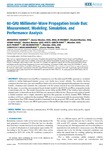Mostrar o rexistro simple do ítem
60-GHz Millimeter-Wave Propagation Inside Bus: Measurement, Modeling, Simulation, and Performance Analysis
| dc.contributor.author | Chandra, Aniruddha | |
| dc.contributor.author | Rahman, Aniq Ur | |
| dc.contributor.author | Ghosh, Ushasi | |
| dc.contributor.author | García-Naya, José A. | |
| dc.contributor.author | Prokes, Ales | |
| dc.contributor.author | Blumenstein, Jiri | |
| dc.date.accessioned | 2019-09-27T15:58:25Z | |
| dc.date.available | 2019-09-27T15:58:25Z | |
| dc.date.issued | 2019 | |
| dc.identifier.citation | A. Chandra et al., "60-GHz Millimeter-Wave Propagation Inside Bus: Measurement, Modeling, Simulation, and Performance Analysis," in IEEE Access, vol. 7, pp. 97815-97826, 2019. doi: 10.1109/ACCESS.2019.2924729 | es_ES |
| dc.identifier.issn | 2169-3536 | |
| dc.identifier.uri | http://hdl.handle.net/2183/24002 | |
| dc.description.abstract | [Abstract] Millimeter-wave (mmWave) transmission over the unlicensed 60-GHz spectrum is a potential solution to realize high-speed internet access, even inside mass transit vehicles. The solution involves communication between users and a mmWave-band on-board unit that aggregates/disseminates data streams from/to commuters and maintains the connection with the nearest terrestrial network infrastructure node. In this paper, we provide a measurement-based channel model for the 60-GHz mmWave propagation inside a typical inter-city bus. The model characterizes power delay profile (PDP) of the wireless intra-vehicular channel, and it is derived from about 1000 data sets measured within the bus. The proposed analytical model is further translated into a simple simulation algorithm that generates in-vehicle channel PDPs. Different goodness-of-fit tests confirm that the simulated PDPs are in good agreement with the measured data. Finally, a tapped-delay-line (TDL) channel model is formulated from the proposed PDP model, and the TDL model is used to study the bit error rate (BER) performance of the mmWave link inside bus under varying data rates and link lengths. | es_ES |
| dc.description.sponsorship | Czech Science Foundation;17-27068S | es_ES |
| dc.description.sponsorship | Czech Science Foundation; LO1401 | es_ES |
| dc.description.sponsorship | Government of India; CRG/2018/000175 | es_ES |
| dc.description.sponsorship | Government of India; Grant 996/2017 | es_ES |
| dc.description.sponsorship | Xunta de Galicia; ED431C 2016-045 | es_ES |
| dc.description.sponsorship | Xunta de Galicia; ED341D R2016/012 | es_ES |
| dc.description.sponsorship | Xunta de Galicia; ED431G/01 | es_ES |
| dc.description.sponsorship | Agencia Estatal de Investigación de España; TEC2015-69648-REDC | es_ES |
| dc.description.sponsorship | Agencia Estatal de Investigación de España; TEC2016-75067-C4-1-R | es_ES |
| dc.language.iso | eng | es_ES |
| dc.publisher | Institute of Electrical and Electronics Engineers | es_ES |
| dc.relation.uri | http://ieeexplore.ieee.org/stamp/stamp.jsp?tp=&arnumber=8744573&isnumber=8600701 | es_ES |
| dc.rights | Atribución 3.0 España | es_ES |
| dc.rights.uri | http://creativecommons.org/licenses/by/3.0/es/ | * |
| dc.subject | Intra-vehicular communication | es_ES |
| dc.subject | 60 GHz channel sounding | es_ES |
| dc.subject | Power delay profile | es_ES |
| dc.subject | Tapped delay line | es_ES |
| dc.subject | Bit error rate | es_ES |
| dc.title | 60-GHz Millimeter-Wave Propagation Inside Bus: Measurement, Modeling, Simulation, and Performance Analysis | es_ES |
| dc.type | info:eu-repo/semantics/article | es_ES |
| dc.rights.access | info:eu-repo/semantics/openAccess | es_ES |
| UDC.journalTitle | IEEE Access | es_ES |
| UDC.volume | 7 | es_ES |
| UDC.startPage | 97815 | es_ES |
| UDC.endPage | 97826 | es_ES |
| dc.identifier.doi | 10.1109/ACCESS.2019.2924729 |
Ficheiros no ítem
Este ítem aparece na(s) seguinte(s) colección(s)
-
GI-GTEC - Artigos [186]






